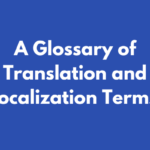Whether you’re an indie game developer or a big studio, one question you should ask yourself – ideally long before your game is finished – is whether or not you want to invest the necessary time and money to have your video game translated into other languages. Will localizing your game make you more money than the localization cost? In other words: Is localization worth it?
While there is no guarantee for success, many developers do report higher sales in foreign countries after localizing their games for a foreign market. Whether or not localization of a video game is worth it depends on many factors, such as the word count and the effort for implementation.
In this article I’ll define localization and explain the difference between localization and internationalization. You’ll also find out what localization entails for a video game, what paths are open to you for getting your game localized and how much it’s going to cost you.
What is Localization?
Localization is the process of adjusting content for a particular locale, or in other words, the process of “making it local”. This can include translation as well as design changes (modifying images, changing layouts, adjusting content) and is usually done to sell a product on a foreign market.
Localization vs. internationalization
Localization is not to be confused with internationalization. While localization is the process of making a product local, internationalization refers to the process of designing software in a way that makes localization possible.
Examples for internationalization
In video game localization, internationalization includes, among other things:
- Making sure that the text in your source language can be exchanged with text in other languages. If you’re hard-coding your text into your programming code, this will cause problems down the line. (Apparently this is why Cook, Serve, Delicious was never localized.)
- Using text boxes with adjustable sizes or adjustable font sizes. A translation into Russian, French or German can increase in size by 15-35%. There needs to be space to accommodate all the additional characters.
- Using fonts that can display special characters. For example, if you want to support German, your font has to display German umlauts (ä, ö, ü), for Spanish, you’ll need upside-down question marks and exclamation marks (¿¡), for Russian you’ll need a Cyrillic font. You’ll also need a license for the font you’re using, obviously.
- Supporting tag systems to account for grammatical differences in other languages. If you use sentences like “Thank you for bringing me the [item]s!”, this will cause problems in many languages. German has three definitive articles (der, die, das) and although sometimes you can create a plural by adding an “s” to a word (Auto => Autos), we also have irregular plurals (1 Haus => 2 Häuser). Obviously, all of these issues are perfectly solvable – e.g. by creating a tag system that can take grammatical genders into account or by turning one string with a tag into many strings without – but this is something you should consider beforehand.
In short, internationalization is a first step before you can start with localization – and the sooner you make your game ready for localization, the happier you will be when the process starts.
Video game localization
Let’s look at video game localization in particular. Here are a few examples of what the video game localization process entails:
- Translating game text and UI text (obviously!)
- Removing culture-specific references not understood in the target locale or replacing them
- Increasing size of text boxes to prevent text overflows
- Removing positive references to alcohol or drugs in games intended for children
- Changing culture-specific design elements (see marujirushi – a red circle in Japanese might have to be changed to a green tick in EFIGS).
If you hire an experienced translator for your video game translation, they will automatically flag everything to you that could cause issues in the target language – like those marujirushi. In order to do that, however, you need to provide them with a playable version of your game, a video of the gameplay or enough screenshots. Good translators will also ask a lot of questions (especially if you don’t provide them with enough context) so you’ll want to set up a way for them to send questions to you. If you’re doing translation in more than one language, it might be useful to go with an online service like Slack to bundle the information for translators and collect questions by translators.
Common languages to translate into
In the localization industry, EFIGS is a commonly used term denoting the languages that are often considered as target languages (i.e. languages to translate into): English, French, Italian, German and Spanish. FIGS speakers are very accustomed to receiving content in their own languages. While in countries with smaller markets – the Netherlands, Norway, Finland – TV programs usually appear with subtitles, in Germany, France, Italy and Spain, movies and TV shows get high-quality dubbed versions. It’s a bit similar to North America, where all non-English movies get grouped as “Foreign Language Films” and even British TV shows get remade to appeal to a US audience (see The Office or Veep), only in Germany, all they do is switch out the voice track – they don’t redo the whole show! So at this point, even though the level of English proficiency in countries like Germany is very high, German consumers expect products to be available in German and will be put off if they are not provided. (It might be worth pointing out that the German vocal minority in forums or on reddit insisting they play everything in the English version don’t actually represent the complete German market – mostly because a large part of the German market doesn’t hang out in English-speaking forums.)
Other languages that are becoming more and more popular to localize into are Russian, Japanese and Chinese. Japan is listed as having an English proficiency of “low”, and yet the Japanese as a people are very enthusiastic about video games – and with 126 million inhabitants, Japan is a huge market. Similar things can be said about China and Russia, although they might have a lower spending power.
For a long time, it was common wisdom that you couldn’t sell games in Russia or Poland because all games were pirated there. This, however, proved to be patently untrue when CD Projekt started localising games into Polish and selling them with added goodies not available in the pirated version – with massive success. So challenge your preconceived notions and consider unusual languages. CD Projekt’s The Witcher 3 has recently been translated into Arabic – which certainly sets it apart from a lot of other games!
The Process
The localization process essentially consists of:
- Finding translators or an agency
- Getting text translated/proofread
- Making localization adjustments
- Localization testing
- Fixing remaining issues
You can follow different paths in order to get your localization done. Let’s look at three methods in detail:
Translation Agencies
The positive: Translation agencies will usually be able to take care of several languages at once, so if you want to do full FIGS localization (plus any number of additional languages), they might be able to handle that for you – along with proofreading and localization testing. This is the expensive but fairly hassle-free method. They can route questions by translators through a dedicated project manager and distribute relevant materials to everyone involved. They are usually able to deal with large volumes of text in several languages, which they do by outsourcing to any number of freelance translators.
The negative: Agencies need to make money for all the project management they provide, so it’s not unheard of that only half of what you’re paying them will end up with the translator who is doing the actual translation work. If an agency underpays their translators, experienced translators will likely go elsewhere and you’re left with the inexperienced ones. (Ideally, the agency will compensate with a good proofreader.) Also, a short turn-around time for a large quantity of text is possible only because translations will be sent out to a larger number of translators at once. Translation output varies between translators, with an average of maybe 2500 to 3500 words a day for simple text requiring little research. Too many cooks spoil the broth, and too many translators can ruin the consistency of your text. If a “sword” turns into a “rapier” midway through, your players will be confused. Of course, good agencies do a thorough proofreading pass and make sure glossaries are used to maintain consistency, but the old adage is true here as well: You get what you pay for.
Freelance Translators
I’m a freelance translator myself, so I think freelance translators are a great option – but I’ll try to be objective here.
The positive: Freelance translators will usually be cheaper than agencies, as they only cover their individual cost and won’t charge you for project management. They will try their best to impress you in the hopes that you will tell all your friends about them – and because they’re hoping you’ll put them in the credits of your game! If you outsource to one translator (or a group of translators that habitually work together) they will produce translations with consistent style and terminology. Finding a translator online is easy nowadays, and while they only translate into their native language, they might have a network of other translators they can recommend to you for your other languages.
The negative: As mentioned before, a single translator is limited by how many words they can translate per day. If your game is huge, translation will take considerably longer at a pace of 3500 words/day than it would with an agency outsourcing to five translators and producing 17,500 words/day. Also, translators usually only translate into their native language, so you will have to find individual translators for each language you want to cover and work out an individual contract with each of them. You’ll also need someone to coordinate and send the relevant files to everyone involved. Lastly, not all translators offer localization testing or proofreading services – so you might have to organize that separately or find a translator who does.
Crowdsourcing
The positive: Crowdsourcing will appeal to many, as this essentially means you’re asking your community of fans to help you translate your game out of the goodness of their heart (read: free!). Crowdsourcing is therefore a lot cheaper than both agencies and freelance translators, so you can offer your game in many different languages you might not otherwise consider. Also, the people who volunteer to translate your game will already know it and like it and be enthusiastic enough about it to dedicate their free time to working on it.
The negative: While crowdsourcing might work, first and foremost you’re having your work done by potentially unqualified people you can’t hold accountable for meeting deadlines or quality standards. After all, what are you going to do if they deliver terrible work past the deadline? Start paying them? Bad translations are bad PR, and if your game has a lot of text and you have many volunteers, the end result might be an inconsistent mess. Another consideration is that crowdsourcing requires community building and so is usually done once your game is already out, which is more difficult from a marketing perspective (as opposed to advertising a game that is available in many languages at launch). Alain Dellepiane wrote an interesting article on the crowdsourced translation of Trucks & Trailers a few years back that is a recommended read if you’re thinking about going in that direction.
Localization tools
If you’ve been looking into getting your game translated, you might have come across mentions of translation memory (TM) tools like memoQ or SDL Trados Studio. These systems are also known as computer-assisted translation tools or CAT tools, and they support the translation process by showing matches or partial matches and keeping track of glossary terms. If a sentence appears twice in a game, the second mention will automatically be inserted (or show up as a 100% match). If there’s a partial match, translators will be alerted to that as well and they can decide if they want to base their translation on the partial match or start from scratch. For video game translation, this is only partially useful, as for dialog or other creative text, you usually don’t want to have repetitions.
In my opinion, TM tools are not something you need to worry about much – that’s for the translator to do. XML or Excel files are common in the localization industry, and whether or not a translator wants to use a TM system doesn’t need to concern you as long as you get your target file in the desired file format.
Having said that, there are two cases in which TM systems might be an advantage to you:
- If you have a lot of repeated text: If for whatever reason, you have a lot of text strings that repeat or are high fuzzy matches, you might ask translators to give you a discount for those. Not all translators will do this, but you can always ask.
- If you’re planning a sequel: If you’re making a sequel to your game, it could be useful to get the TMs and term bases (i.e. glossary files for use with TM systems) of the first game to use for the translation of the next game.
How much does it cost?
Right, let’s get down to juicy bit where we talk numbers! Translation can cost you anything between about 0.08 USD and 0.20 USD per word and usually translators will charge you a minimum fee to cover administration tasks like sending you an invoice. This is a fairly big spread, of course, meaning a translation of 10,000 words could cost you either 800 USD or 2,000 USD – so which is it?
Well, it depends. You’ll likely get freelance translators working from English into FIGS on the lower end of this spectrum, then the price gets higher for rarer language pairs (e.g. English – Japanese) and for additional services like an extra proofreading step by another linguist. Agencies will also move the price further towards the middle of the spectrum. If you realize you need something translated ASAP and it’s Friday evening or a public holiday, there’ll likely be an additional rush fee and you’ll end up at the high end of the spectrum. Then again, if your game is massive or has a lot of repeated strings, you might be able to negotiate a discount. Think about which services you need exactly and shop around.
As a concrete example, let’s say your game has 9,500 words and you have 500 additional words of marketing text (e.g. a game description for Steam). If you get a freelance translator for 0.10 USD/word, you’re paying 1,000 USD for one language, so 4.000 USD for FIGS. Maybe an agency would charge you 0.14 USD a word so it’ll cost you 5,600 USD, but you don’t have to invest time in finding individual translators.
If you need a small chunk of 225 words a week or two after all the other translations are done because you changed a few descriptions in your text, a translator or agency who agreed to do translations for 0.10 USD a word might charge you their minimum fee of 45 USD (instead of 0.10 USD * 225 = 22.50 USD), bringing the price per word up to 0.20 USD.
Then again, if your game has 200,000 words, maybe you’ll find a freelancer who gives you a bulk discount and translates your text for 0.09 USD a word, but it might take them three months to do it.
And lastly, if you’re thinking “Oh, but I’ve seen this guy on Fiverr who translates for 0.02 USD a word!”, I’ll say this: Get your game machine-translated instead. Both results will be completely unusable, but at least you’ll save 0.02 USD a word!
Is it worth it?
All that needs to happen now is for you to make more money off the translation than you paid for it. Easy, right? Well, if you take your cost and divide it by the money you make off each sold copy, you’ll get an idea of how many copies you need to sell in order to turn a profit. As a developer, ideally you’ll have an idea whether or not that is attainable. If your game costs 200 USD to translate into German and you make 7 USD off every copy you sell, you’ll make your money back once you sold 29 copies. That sounds a lot more attainable than having a game with a million words and having to sell almost 14,290 copies to break even.
There are a few developers out there who have openly talked about what localization has done for their game, one of them being the makers of Gremlins, Inc. who have had very good sales results thanks to their localization. They reported in 2017 that about 70% of players of their game play in languages other than English. They’ve been very successful with their Russian version, likely because part of their development team is Russian and so all their communication has been in English and Russian from the start. Plus, they’ve had huge success with their Chinese translation and one of the main points they took away from their experience with their game is that in order to reach the Asian market, you must localize your game into those languages.
Jonas Wæver of Logic Artists talked at GDC about localization for their game Expeditions: Conquistador (see around 19-minute mark) and the substantial extra profit they made by having the game localized into German. He also talked about the impact it has on your PR if you release additional languages after the official English release: The gaming media will report on your game when it first comes out, but making other languages available likely won’t be important enough for them to write about your game again.
At another talk at GDC 2012 titled Conquering European Localization, Danica Brinton of LocLabs talked about how in mobile games, there is a 30-60% increase in downloads in the locale you localize for, followed by increased monetization. In the same talk, Nadine Martin of Sony Computer Entertainment Europe explained how for console games, users expect a fully localized game since they pay a lot of money for it – therefore localization is a given for them. I imagine she’s referring to AAA games there, though – and speaking of which, there is also a very interesting talk by Judith Matz of Crytek at GDC 2012 in which she talks about the localization of Crysis. While that talk doesn’t mention sales numbers, it mentions some of the issues they ran across in their localization efforts. So definitely watch that if you want to know all about what can go wrong in localization.
Conclusion
My conclusion to all of this is: Localization can potentially make you a lot of money – especially in the mobile market – as long as you plan with localization in mind from the beginning and the number of words used in your game is proportional to its expected marketability.
If you’re ever interested in having your game localized into German, feel free to get in touch with me via info@translationgeek.de. I’ll happily tell you all about my video game translation services and give you a free quote on your project.
Photo credit: The image of the controller is by Chris Liverani.






Great article. Plenty of intelligent information that I hope (as a localizer myself) the clients will take on board. Thanks.
Glad you liked it!
hi.im writing an article about video game localization.but i cant find a suitable questionare to spread out among the gamers who play both localized and unlocalized game.would you please help me?
Make your own with Survey Monkey?